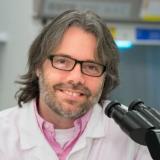Professor Jose Polo’s work in epigenetics spans diverse fields, including cellular reprogramming, embryogenesis, neurobiology, immunology and cancer. His Synergy Grant brings together a multidisciplinary team who will combine the latest advances in models of early development, genetics and molecular biology to determine how the early placenta produced by the embryo burrows into the uterus and keeps developing during the entire pregnancy.
Professor Polo received the 2022 NHMRC Fiona Stanley Synergy Grant Award, recognising the top-ranked Synergy Grant and named in honour of Professor Fiona Stanley AC FAA. Professor Stanley is an epidemiologist known for her contributions in researching the causes of major childhood illnesses such as birth defects and her focus on Aboriginal child health and wellbeing. Read on to find out more about Professor Polo’s research, in his own words.

The essential role of the placenta in pregnancy is unquestionable, but surprisingly it is the human organ we know least about. How does the placenta, the baby’s lifeline, develop, particularly in the first few weeks?
Furthermore, implantation and placental disorders are central to infertility, preterm birth, and poor maternal and infant health over the short and long term. Indeed, up to 30% of the 300,000 pregnancies each year in Australia are affected by a major pregnancy complication that is associated with defects in placental development.
Gestational diabetes, preterm birth, small gestational age, and pre-eclampsia affect 15%, 9%, 10%, and 5% of Australian pregnancies, respectively.
The processes of implantation and early placentation are essential for a successful pregnancy.
However, despite its obvious importance to human health, we are yet to determine the molecular and cellular interactions governing this process and its failure, which are key to developing future therapies.
Our program aims to deliver important new knowledge on placenta formation.
We will focus on how the early placental trophoblast lineages arise during the implantation process that occurs before a woman is aware she is pregnant. We will use the best models to date to elucidate how the early trophectoderm and trophoblast cells interact with endometrial cells and burrow into the uterine stroma in pregnancy. We will determine how epigenetic changes in these cells direct their differentiation and lay the foundations for how the placenta will form and function for the rest of gestation.
We will not stop there, and we will track the different molecular and cellular changes across early-mid gestation and thence to term placenta.
Our new insights into the earliest days and weeks of placental development including implantation will provide unprecedented knowledge of the mechanisms that increase these risks and identify therapeutic targets.
This in turn will potentially reveal new treatment options for the thousands of women that suffer pregnancy related diseases as well as the 15% of couples worldwide who face infertility. Solving a problem of such complexity requires the cognitive diversity of research teams and individuals from different backgrounds to work together.
A single laboratory is unlikely to have all the experience, knowledge, and innovative thinking necessary to address such complex problems and deliver innovative solutions to make a significant impact on society.
Therefore, the Synergy Grant scheme was ideal to tackle this vast problem as it allowed us to assemble a multidisciplinary team with all the necessary expertise and skills required to address this multifaceted knowledge gap.
Our team brings together the fields of developmental and stem cell biology, placenta and endometrial biology, epigenetics, genome engineering, single cell-omics and computational biology. I am very honoured to be leading this team of extraordinary scientists.
We are coming together as one as an unprecedented collective force with a dedicated focus to revolutionise placental research.
We collectively aspire to discover, understand, and apply new knowledge of human implantation and placentation to improve pregnancy outcomes and life-long health for mothers and their babies.
